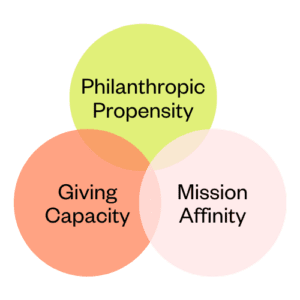
Good things come in threes. When it comes to ideal donor ratings, the big three are propensity, affinity, and capacity (The Three Keys). Throughout the nonprofit industry, there are many different perspectives and names for this ratings trio. But what do propensity, affinity, and capacity ratings actually mean? We’re here to chime in with our thoughts about The Three Keys in relation to prospect research tools. Ready to learn?
If you are unfamiliar with defining a prospect with the Three Keys, here is the breakdown:
PROPENSITY: Has this person given to nonprofit causes before?
AFFINITY: Is this person passionate about your cause and nonprofit organization?
CAPACITY: How much wealth can this person afford to donate?
You may know propensity as inclination and affinity as linkage or connection. Capacity to give is just another term for a person’s ability to give their wealth to nonprofit causes. What’s important to remember is that no matter what you call donor ratings, they help you guide prospect research and frame major gift asks.
 Imagine a Venn diagram of propensity, affinity, and capacity. David Lawson of Working Philanthropy wrote that “…someone with money who is a giver to others can still not be into your mission. Another might love everything you do, but has no discretionary dollars to share.” Two ratings may overlap, but the sweet spot in the middle is when all three ratings are known and support each other. That is when you really know you have a great prospect.
Imagine a Venn diagram of propensity, affinity, and capacity. David Lawson of Working Philanthropy wrote that “…someone with money who is a giver to others can still not be into your mission. Another might love everything you do, but has no discretionary dollars to share.” Two ratings may overlap, but the sweet spot in the middle is when all three ratings are known and support each other. That is when you really know you have a great prospect.
What is Propensity?

The Merriam-Webster Dictionary defines propensity as “a strong natural tendency to do something.”
Perhaps the key word in Webster’s definition is “natural”. A natural willingness to give is a highly desirable trait of the ever-elusive ideal donor. It is much easier to establish relationships with people who genuinely want to be philanthropic rather than trying to coax philanthropic tendencies from scratch. Luckily, identifying prospects based on their propensity doesn’t have to be a case of shooting in the dark.
In many ways, understanding propensity is like sketching a prospect’s portrait. Each researcher might define propensity differently according to the type of nonprofit they work for and the campaign they are doing the research for.
This first step lets researchers and developers ask questions: Who is this person? What is their personal approach to philanthropy? Where have they given before? How often did they give? How much did they give?
Wouldn’t it be great if we could find clues into their behaviour? We have you covered.
Finding Clues
Giving history (or lack thereof) provides clues about propensity. Examining a prospect’s giving history helps identify personal philanthropic trends. For example – Donor A may give small amounts in regular increments, while Donor B awards a major gift annually. Donor C may donate their time as a volunteer, board member, or pro bono consultant. Although there is no universally perfect donor, different nonprofits may consider the above donors ideal to them. As you can see, past behavior is a key clue when looking to find donors with propensity to give.
If we assume prior giving is a good indicator of future giving, the best candidates for future giving must be your current donors, right? Review your organization’s records to determine who has given their time or money (or both!). You can also input your donors’ names into your prospect research tool’s Recency-Frequency-Monetary (RFM) scoring system. This provides information about a donor’s most recent gift (recency), how often they donate (frequency), and the gift amount (monetary).
How Do I Find Propensity?
But what if your nonprofit is brand new? What if there are cobwebs in your donor database? What if you’ve never used Fundraising Intelligence software before? Fear not!
Determining propensity for prospects requires a healthy amount of skepticism and due diligence. Unlike internal-focused research, your Fundraising Intelligence platform gives you access to external records of past giving to organizations other than yours. When using your platform, remember to perform an integrated search across all datasets and also within each individual dataset. You may uncover records in individual datasets that a broad search may miss.
Some platforms allow users to target giving history searches over a specific year or range of years. Try searching for different types of gifts, like endowments, event sponsorship, and volunteer time. It’s also important to verify prospect records to confirm their validity and relevance.
Best Resources to find Propensity Data
So what are the best resources or datasets to find records indicating propensity?
Charitable donations data is an excellent place to start. Again, we return to our understanding that past giving is a good indicator of future giving. In Kindsight’s VeriGift charitable giving database, users can search for gift givers or gift recipients in the United States and Canada across date ranges, gift amounts, and gift types. Pretty cool, right?
Also consider exploring a foundations dataset, such as Candid. You can learn about your prospect’s affiliation with foundations (including both private and public charities) in Canada and the US. You can also learn if your prospect or donor sits on the board of other nonprofit organizations or if they have connections with board members.
Remember that a prospect giving their “time” is also a great indication of philanthropic tendencies. And who knows, maybe that volunteer is keeping their donations anonymous? Especially look out for prospects and donors who support organizations in your same NTEE category.
What is Affinity?

Affinity is defined as whether someone gives to causes similar to yours. At Kindsight, we understand affinity (or linkage) as the strength of a person’s connection to a cause or mission. Affinity is all about relationships and connections.
While it is important to know about a prospect’s wealth and philanthropic history, affinity is arguably the most important element of the PAC rating or score. The likelihood that someone will give a large gift depends heavily on the connection they have with your organization.
Look to your current donors.
Many times your best prospects are likely in your database already. These donors also have an established history with your organization. This makes it easier to evaluate your relationship with these donors and identify new opportunities to further develop these relationships.
See if you can spot the opportunities here:
- Donor A is the husband of a board member at your organization. He is a retired business consultant and frequently attends fundraisers with his wife, the board member. He is an annual giver, but is otherwise inactive.
- Donor B is an alumni and former shining star on your school’s varsity soccer team. Donor B has given very small gifts to the school each year since graduation, but she is finally on her feet with a successful physiotherapy practice. The school is building a new soccer facility and needs to fundraise for a training and rehabilitation center.
- Donor C has been involved with your hospital foundation since he was a child. He volunteers several hours a week and seems to know every patient and their families by name. He is an outspoken advocate for your hospital and its cause, but he doesn’t have the resources to donate a major gift.
What do you see?
Could you inspire passion in Donor A by asking him to volunteer at your next fundraiser, or perhaps consult on a special project? How could you appeal to Donor B’s strong connection with your school’s athletics program? Donor C may not be a good major gift candidate, but maybe as a champion of your cause, he knows people who are.
Examine your donor database. Look for committed donors who provide great value to your organization over their lifetime. Determine if the donor or their families have been recipients of your services. Consider their attendance at events, their volunteer record, and if they engage with your organization by subscribing to your marketing material, connect on social media, or participate in fundraising campaigns.
Consider Wealth Screening.
Wealth Screening will match each donor or prospect to wealth, philanthropic, and biographical records. I you build a list of your current top supporters and lapsed donors, wealth screening can create a report that provides the complete year-by-year giving history of each donor based on the parameters you set. For example, it can show you who has given more than, for example, $100 in a single gift to any organization. This number is, of course, adjustable to whatever works for your organization.
Furthermore, leveraging live profiles for a group of prospects can help you prioritize your best prospective donors by giving you real-time alerts about any pertinent changes to their profiles.
Everyone?
At a minimum, everyone in your organization’s circle should be asked for an annual donation. A common response is, “sure, it’s important to remind donors. But everyone? Really?” Don’t assume your board members or volunteers will always remember to give, even if they are expected to. Keeping up to date with all stakeholders and nurturing relationships with them is a full-time, year-round job, but it is critical to fundraising success. Leave no stone unturned!
Determining affinity for prospective donors requires more digging. Again, a Live Profiles can help prioritize the best prospects. Beyond that step, your own current donors continue to provide value. Remember Donor C, who seems to know everybody including those unknown to you? Everyone is familiar with the concept of networking. You can use similar strategies to raise awareness and grow your organization’s network.
Think outside the box.
This means look to new individuals outside your database!
Here’s a tip when using Kindsight to determine affinity. Within Kindsight, you can search across different affinity categories, such as Education, Health, or Arts and Culture, and the Humanities. Let’s say your university is fundraising for a new nursing school. You may be limiting yourself by just searching the Education category. Search for connections to Health as well, and you may uncover information about current or prospective donors you didn’t know about before.
Remember Bill Gates?
Oh yeah, that heartbreaker.
It’s easy to get caught up with details about a prospect’s wealth capacity. That said, capacity to give is a critical component of understanding your prospect. And it’s true, some donors considered to be lost causes like Bill will surprise you. But as a rule of thumb, look at affinity as the foundation of your relationship with a new donor. Establish common ground, identify opportunities, and go from there.
Propensity ratings are important. Capacity ratings are really important. But neither are more important than affinity.
By the way, don’t worry about Bill Gates! There are many more fish in the sea.
What is Capacity?

You probably already know what capacity is, but the way we think of it is this: How much does your prospect have to give?
Capacity ratings represent the total amount the prospect can give to all causes over a 5 year period. And to be clear, this rating or range does not include propensity or affinity.
Many organizations have a multi-pronged approach that takes all three ratings into account but still think about them separately. It’s okay for someone to have a high capacity where there is no notion of philanthropy.
The good news: Capacity ratings are extremely helpful for a gift officer asking for a major gift.
The bad news: There is no one-size-fits-all formula for determining capacity to give.
The Three Types of Capacity Ratings
1) Baseline: Based solely on 1-2 assets in a manual search, or based on valued assets matched through electronic wealth screening or prospect research tools.
Uses: This is an unverified rating. This means it gives a quick snapshot of your prospect’s potential ability to give. But it is just that: a baseline or a starting point – not a crafted ask amount. Baseline ratings can be used for prioritizing or segmenting donors to see which donors are worthy of deeper research. Pass this information to a gift officer only if they understand the profile is unverified.
2) Verified or Confirmed: Manual research identifies wealth, wealth indicators, and applies a method to create a capacity rating.
Uses: Those individuals or segments identified in the baseline rating to have potential as major gift donors, need to be verified. But what verification actually means is different for different organizations and even for different gift officers.
3) Strategic: Manual research dives deep to identify as many factors as possible, often narrowing the range of the rating to assist in crafting an ask amount.
Uses: This is the holy grail of capacity ratings. It requires a significant amount of time but is accurate enough to assist in determining an ask amount range.
Determining Capacity
Now this is where caution is needed. If you started reading this post hoping that you were going to get tried and true capacity rating formulas to use, you’re going to be disappointed. Remember the bad news from before? There is no one-size-fits-all formula to give you and there are no 100% right answers.
Ratings are only as good as the records used to calculate them. Records are only as good as the public information available.
Information for Ratings
Income
Annual income information comes from several sources. The general rule of thumb using annual income to determine a capacity rating is 10% of income.
Real Estate Holdings
Real estate holdings are perhaps the most popular and arguably the most accurate source used to calculate wealth. They represent all of the properties owned by the individual, even those properties listed under a trust or LLC. These properties are hard to find, but here are some tips for doing so. The reason real estate is so popular is because for 80% of the population, it is the only piece of data you can find on them. And that’s if you’re researching a prospect in the US. In other countries, it’s even higher than that.
Stocks and Assets
Use stocks and assets to generate a baseline rating as well. In fact, they are one of the data points used in Kindsight. The information from this calculation comes from the Thomson Reuters database and is based on current estimated holdings.
Charitable Giving
Next, charitable giving is an excellent, trusted indicator of capacity. There are many ways to analyze charitable giving to determine a rating. One simple rule of thumb for calculating a baseline capacity is the Average of total donations by year, multiplied by 5. Be sure to review Verigift for a prospect’s past-giving history.
It’s Not Only About Data
Capacity is a broad topic with a lot of perspectives and a lot of customization per organization. It’s not only about the data. Strong communication is key. Determine what information the gift officer needs and what they have. They may know of other indicators of a more qualitative nature. This strong communication really comes into play in the verified and strategic capacity ratings as deeper research is required.
Ready to Learn More?
Having a Fundraising Intelligence platform that can prioritize affinity is key; it’s considered the most important element of a prospect rating scorecard. Knowing a prospect has a proven interest and passion for your cause can give you a head start in finding the major gift donor of your dreams.
Be the first to read our resources.
The world is changing quickly—and our resources help you stay on top of it all. Sign up to get new insights, success stories, and more, sent right to your inbox.




